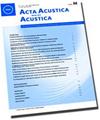Detection Thresholds for Combined Infrasound and Audio-Frequency Stimuli
Q1 Arts and Humanities
引用次数: 8
Abstract
This study investigated whether the presence of audio sound (20 Hz < frequency f < 20 kHz) influences the detection threshold for infrasound (f < 20 Hz), and, vice versa, whether the presence of infrasound influences the detection threshold for audio sound. Monaural detection thresholds of thirteen otologically normal listeners were repeatedly determined for infrasound stimuli (sinusoids at 5 Hz and at 12 Hz) and for audio sound stimuli (sinusoids and bandlimited pink noise), separately and in presence of the respective other sound type. The measurements were performed with an adaptive 1-up-2-down 3-alternative forced-choice (3-AFC) procedure. Threshold levels for infrasound stimuli were not affected by audio sound at +5 dB sensation level (SL), but they were significantly increased by the presence of some of the audio sound stimuli presented at +50 dB SL. For example, thresholds for the detection of infrasound increased on average by around 5 dB when simultaneously presented with a pink-noise stimulus (frequency range: 250 Hz– 4000 Hz). On the other hand, the presence of infrasound with levels up to +10 dB SL did not cause any significant change in the detection thresholds for audio sound. This could be an indication that infrasound might even be more annoying in a quiet environment.次声和音频联合刺激的检测阈值
本研究考察了音频(20 Hz <频率f < 20 kHz)的存在是否影响次声(f < 20 Hz)的检测阈值,反之亦然,次声的存在是否影响音频的检测阈值。对13名耳科正常听者的单耳检测阈值进行了反复测定,分别测定次声刺激(5 Hz和12 Hz的正弦波)和音频刺激(正弦波和限带粉红噪声),并分别测定其他声音类型的存在。测量采用自适应1-上-2-下- 3选择强制选择(3-AFC)程序进行。次声刺激的阈值水平不受+5 dB感觉水平(SL)的音频的影响,但当出现+50 dB SL的音频刺激时,次声刺激的阈值水平会显著提高。例如,当同时出现粉红色噪声刺激(频率范围:250 Hz - 4000 Hz)时,次声的检测阈值平均提高约5 dB。另一方面,次声水平高达+10 dB SL的存在并没有引起音频检测阈值的任何显着变化。这可能表明,在安静的环境中,次声甚至可能更烦人。
本文章由计算机程序翻译,如有差异,请以英文原文为准。
求助全文
约1分钟内获得全文
求助全文
来源期刊
CiteScore
2.60
自引率
0.00%
发文量
0
审稿时长
6.8 months
期刊介绍:
Cessation. Acta Acustica united with Acustica (Acta Acust united Ac), was published together with the European Acoustics Association (EAA). It was an international, peer-reviewed journal on acoustics. It published original articles on all subjects in the field of acoustics, such as
• General Linear Acoustics, • Nonlinear Acoustics, Macrosonics, • Aeroacoustics, • Atmospheric Sound, • Underwater Sound, • Ultrasonics, • Physical Acoustics, • Structural Acoustics, • Noise Control, • Active Control, • Environmental Noise, • Building Acoustics, • Room Acoustics, • Acoustic Materials and Metamaterials, • Audio Signal Processing and Transducers, • Computational and Numerical Acoustics, • Hearing, Audiology and Psychoacoustics, • Speech,
• Musical Acoustics, • Virtual Acoustics, • Auditory Quality of Systems, • Animal Bioacoustics, • History of Acoustics.

 求助内容:
求助内容: 应助结果提醒方式:
应助结果提醒方式:


